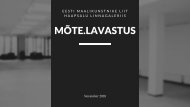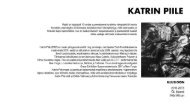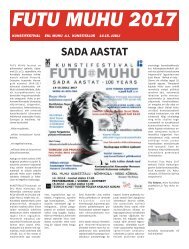minimal.kaks
You also want an ePaper? Increase the reach of your titles
YUMPU automatically turns print PDFs into web optimized ePapers that Google loves.
Minimalism describes movements in various art forms, especially visual art
and music, where the aim of the work is to reveal the content, nature or identity
of the subject, eliminating any insignificant forms, features or concepts.
The exhibition presents four different authors; four different directions on a map of the
minimalist painting.
The birth of minimalism is considered to be the beginning of the 20th
century, when the adaptation to the modernist syndrome of progress and the spiritual
demand to “jump over” the powerlines of the machinery of that era became the
basis for the endeavor of the phenomenological absolute.
The black icon of minimalism: square as an absolute emptiness and chaos,
containing the universe, is a positive counterpart to the nihilistic ultimate
goal of the modernism. In the course of cyclical art developments, the style
vigorously re-emerged in American art of the 1960s and 1970s. Inspired by constructivism;
from the preliminary projects of Kazimir Malevich, De Stijli´ and
Marcel Duchamp, minimalist artists brought the narratives of abstract expressionism
back to purely self-referential geometric forms. Emptyed from external references, in the
second half of the 20th century the direct formal presence of an art object came to the
fore - the physical properties of the work, the relationship with the
surroundings and the cognitive experience of the viewer became primary.
Today’s Estonian minimalist painting has both formal and substantive features of
minimalism; the solipsistic spiritual vector, the feeling of slowing down, stopping
and jumping over time, and the refined aesthetic approach in the formulation of the
message are constantly present here. Much based on aesthetic as on the philosophical
principles makes Estonian minimalism a deeply spiritually enjoyable experience.
Exhibition takes a look at four different authors, allowing the viewer to delve into
the depths of “laconicism”, to assume the initial impulses of art style rhetorics, its basic
structures; to perceive the slowly working meditative and tuning effect of the works.
Tiiu Rebane












